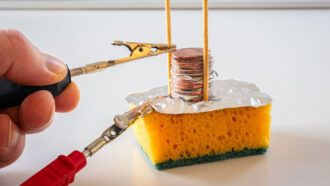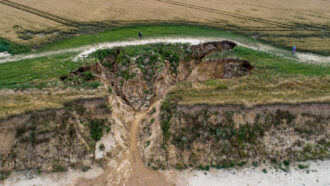Science Buddies

All Stories by Science Buddies
-
 Tech
TechExperiment: Make the fastest rubber band paddleboat
With a rubber band and some cardboard, you can build your own paddleboat to speed across the surface of a pool.
-
 Materials Science
Materials ScienceExperiment: How much water is needed to cook pasta?
In this cooking experiment, let’s find out if we can save time, energy and resources by boiling noodles in less water.
-
 Chemistry
ChemistryExperiment: How to keep fruit slices fresh
Let’s explore why fruit tends to brown over time and how to keep it looking fresh.
-
 Materials Science
Materials ScienceExperiment: The surprising strength of eggshells
Architecture is full of arched doors, windows and other structures. But how strong is the natural arch of eggshells?
-
 Chemistry
ChemistryExperiment: What makes ice melt fastest?
During the winter, you might have seen trucks spreading a mix of salt and sand on the roads to de-ice them. But how does that work? Let’s investigate.
-
 Planets
PlanetsExperiment: Make your own craters!
Let’s make our own craters in cocoa and flour to learn how these features form throughout the solar system — and why they’re different sizes.
-
 Physics
PhysicsExperiment: Making music with bottles
In this study, we investigate how the volume of air inside a bottle affects the pitch of the musical notes it can create.
-
 Humans
HumansExperiment: Why does the moon look larger on the horizon?
In this experiment, let’s investigate Emmert’s law, which may explain the full moon optical illusion.
-
 Physics
PhysicsExperiment: Measure the speed of light with a laser
Grab a laser pointer and some Jell-O, because today we’re measuring the speed of light.
-
 Chemistry
ChemistryExperiment: How to make the boldest, brightest tie-dye!
Clothes are made from a variety of fibers, from natural to synthetic ones. Let’s explore how different fibers react with dyes.
-
 Physics
PhysicsExperiment: Make your own cents-able battery
Make your own ‘voltaic pile’ with pennies and nickels, and find out how many coins will make the most electricity!
-
 Earth
EarthExperiment: Can plants stop soil erosion?
Soil erosion washes pollutants into streams and rivers — but plants may help limit that.